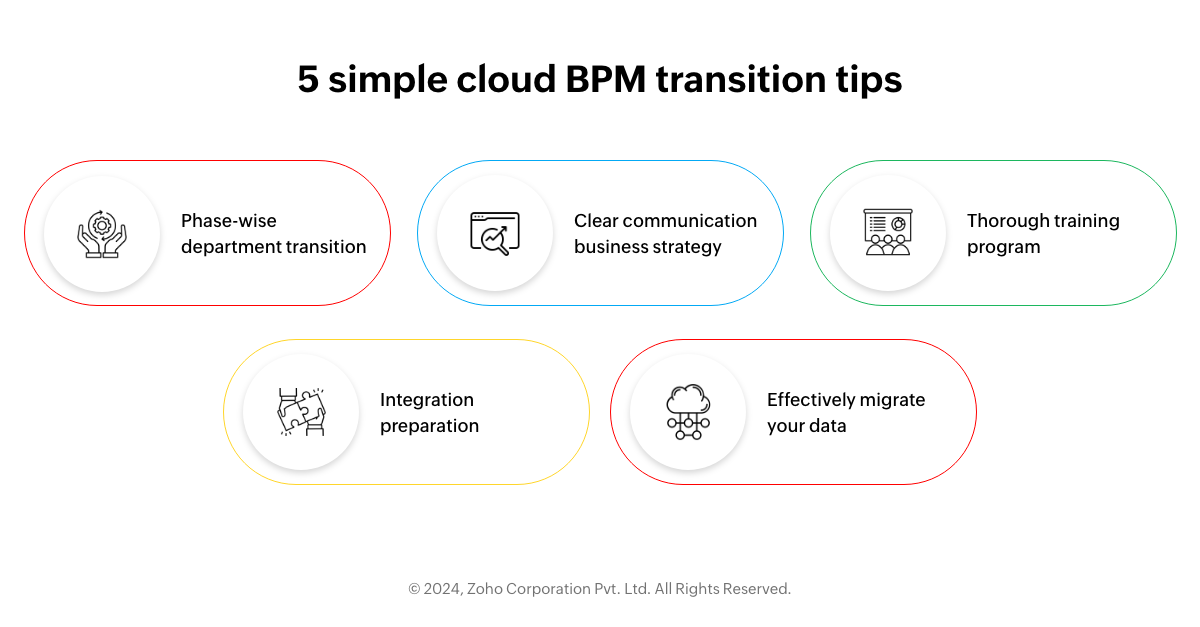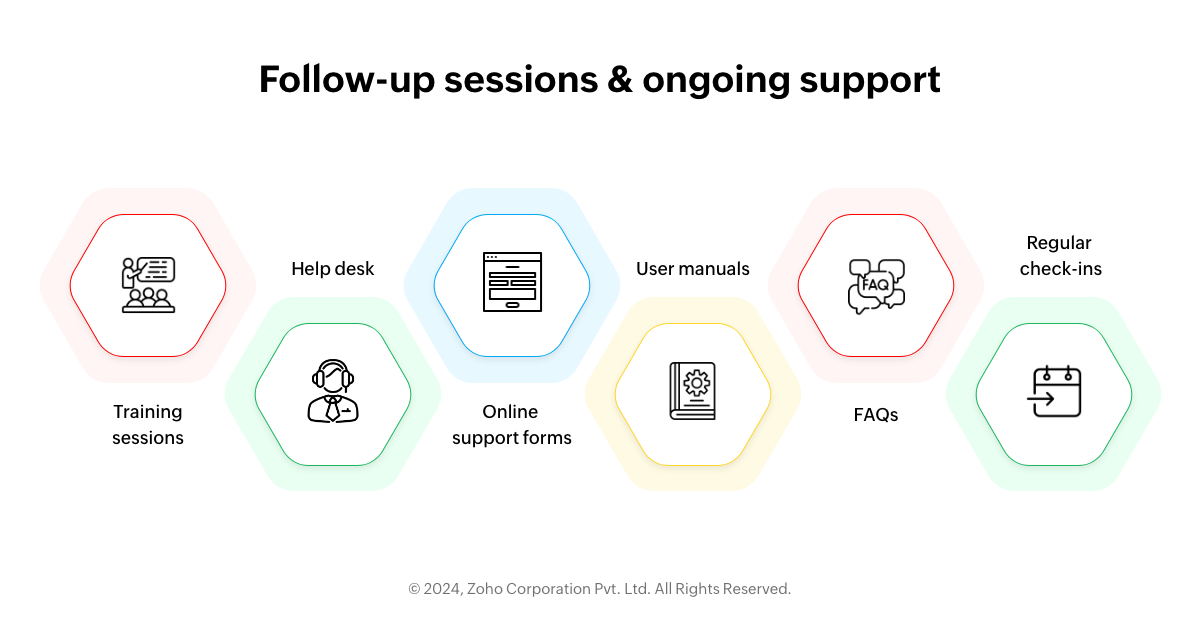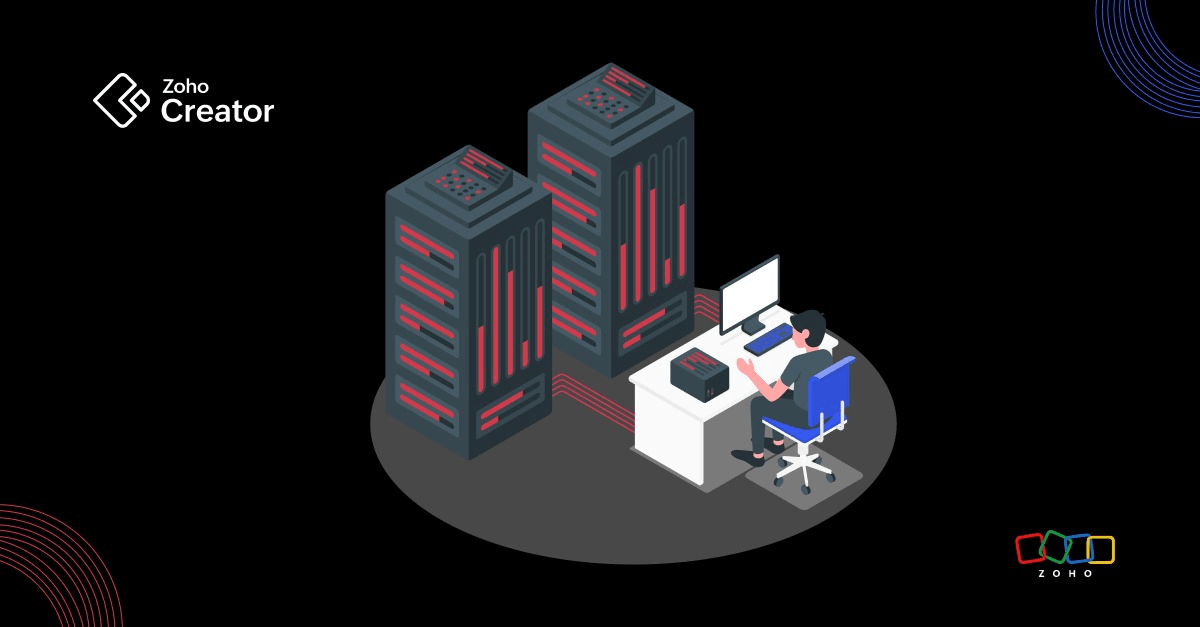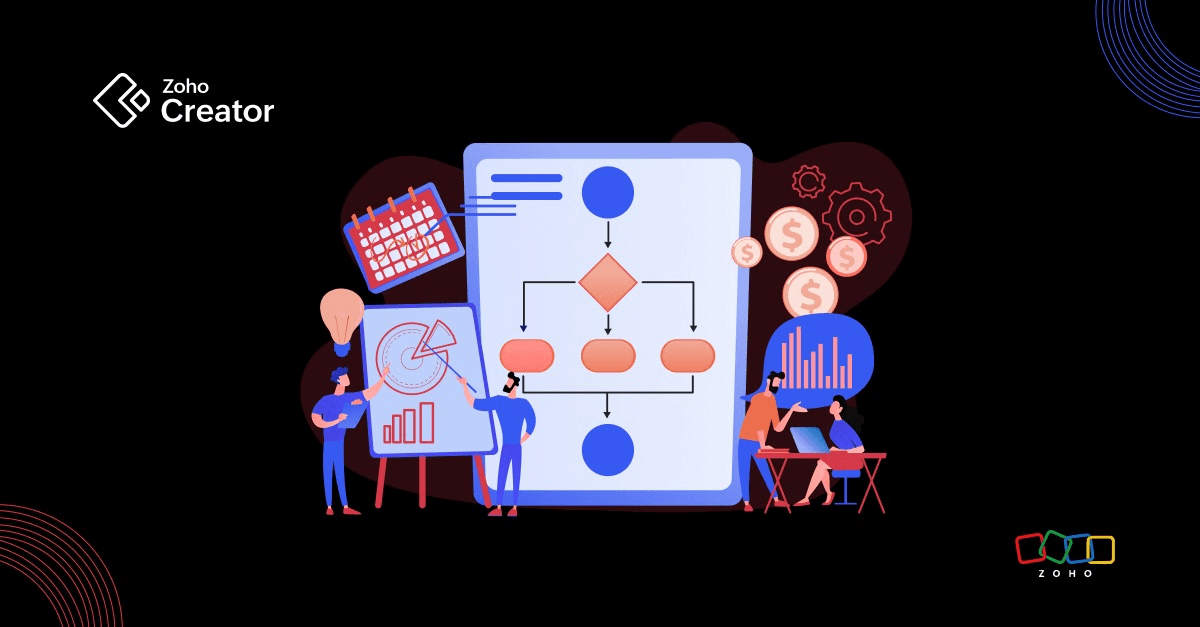- HOME
- Know Your Tech
- 5 simple tips for transitioning to cloud BPM software
5 simple tips for transitioning to cloud BPM software
- Last Updated : March 17, 2025
- 615 Views
- 10 Min Read
Business process management (BPM) offers teams a structured approach to align their internal business processes with organizational guidelines and KPIs. This facilitates the standardization of business processes and improves communication among stakeholders. An effective business process management software simplifies the task of designing, implementing, monitoring, and enhancing your business processes.
Switching to cloud BPM software offers numerous advantages, including enhanced accessibility, improved security, and reduced maintenance overhead. However, switching to a platform can't just happen in a day—you need to plan for it carefully.
It’s really important to have a clear and effective business process management strategy in place before choosing a tool. Each business has its own unique processes, so it's necessary to make sure everything is consistent, manual errors are minimized, and business operations run smoothly.
Here are five simple tips to ensure a smooth migration for your organization.

1. Phase-wise department transition
Transitioning to business process management software is a complex task that requires a strategic approach. One of the most effective strategies is to transition the department in phases in the cloud. This method minimizes confusion and chaos and can prevent potential revenue loss. Here are a few steps on how to manage it properly.
Start with a pilot department
Begin with a crucial process in one main department. This initial phase acts as a pilot test, allowing you to identify and address potential issues before a company-wide rollout. So, selecting a department that is both critical and adaptable is suggested.
For example, HR might be a good starting point. This is due to its organization-wide impact and their need for streamlined processes. Some HR processes that can be subject to BPM transformation include onboarding, payroll, and performance management. These are applicable to all employees, making the department a logical choice for a pilot.
Establish metrics
The next step is to establish clear metrics for success. This includes reducing process completion time, increasing user satisfaction, and fewer errors. So, take your time to track the time taken to complete key HR processes before and after the cloud transition. Please remember to use surveys to gauge user satisfaction with the new system. And, most importantly, monitor the number of errors or issues reported during the process execution.
Then, how do you closely monitor the implementation? Use real-time analytics and dashboards provided by the cloud BPM software to track progress and performance. Always be prepared to make any adjustments based on the feedback and the data collected. For example, if users report difficulty with a particular workflow, you can tweak the existing process or provide additional training.
Test and scale with continuous improvements
In the previous step, we discussed adjusting the process based on feedback. But how will you collect the feedback of your pilot process? This can be done through surveys and direct interviews.
You can deploy quick surveys after every key process to gather immediate feedback. And you can conduct in-depth interviews with key users to understand their experiences and challenges separately.
Now, you must use the feedback to make continuous improvements. Once the pilot phase is successful with the desired outcome, plan the cloud transition for the next department. For example, if HR successfully transitions, consider departments like finance or marketing, using the best practices and lessons learned earlier.
Use early adopters
After setting up with various departments, set up a team of early adopters who can assist with other teams. They can provide hands-on training for new users, offer ongoing support, answer questions, and share insights and practical tips to ease the cloud transition.
Also, workshops can be organized where the pilot departments can share their knowledge.
Manage expectations
How will you manage the transition metrics to the new cloud BPM software? Always keep an eye on the timeline you have set, which should clearly specify dates for each phase of the switch. Take time to understand how each department will benefit—whether it's smoother processes, better collaboration, or cost savings—and align these business process improvements with your business operations and goals.
Encourage your team to make full use of the support resources and training sessions. The main aim of this step is to ensure everyone is comfortable with the new system. Another crucial part to take care of is being aware that buffer periods are included to handle unexpected delays smoothly.
2. Clear communication business strategy
Multiple communication channels
It’s always optimal to use a variety of communication channels to ensure that everyone is informed about every change made. Some of the effective communication channels include email announcements, virtual meetings, and open forums.
Consistent messaging
Always ensure that the messaging is consistent across all communication channels. Provide clear and concise information about the transition, including the benefits of the new system, the timeline for the transition, and the support available to employees.
Identify key individuals who will communicate these messages. Ensure they’re well-informed and aligned with the overall communication strategy. Provide regular updates to keep employees informed about the progress of the cloud transition. Transparency is key to maintaining trust.
Open feedback loops
Encourage feedback from employees at all stages of the transition. Create open platforms where employees can voice their concerns, ask questions, and provide suggestions. This feedback can be invaluable in addressing any issues and improving the transition process.
Be open to incorporating feedback into the transition process. If employees suggest improvements or highlight issues, take them seriously and make necessary adjustments. This not only improves the transition process but also shows employees that their input is valued.
3. A thorough training program
We have already discussed the importance of setting up training programs in-house. Now, let’s go over a few more important steps to be taken care of while conducting training sessions. Because even if the new platform is intuitive, there will always be a learning curve. Here's how to ensure thorough training.
Vendor-led training
Always engage the cloud BPM vendor to provide initial training sessions. These sessions should cover the basics of the platform, as well as any advanced features that employees will need to use. Make sure that the training sessions are interactive where the employees can ask questions and engage with the trainer.
For example, HR employees might need specific training on features related to payroll and performance management.
Follow-up sessions
Training should not be a one-time event. Schedule follow-up sessions to reinforce the initial training and address any questions or issues that arise about the new cloud BPM system. These sessions can be targeted at specific groups or departments, focusing on their unique needs and challenges. So, the training sessions can be scheduled at regular intervals to ensure the users are getting used to every feature of the cloud process.
Develop comprehensive materials that are easily accessible to all employees, providing them with the ongoing support they need to navigate the new system after the training. This can include a dedicated help desk, online support forums, user manuals, FAQs, and regular check-ins with key users.

4. Integration preparation
Integrating the new cloud BPM system with your existing software is essential for a seamless transition.
Identify critical integrations
When moving to a new cloud BPM platform, it's essential to figure out which software systems need to be integrated. Typically, this includes your financial systems, HR software, ERP systems, and other crucial tools. Prioritizing these integrations assures that your core business processes continue without disruption.
First, jot down a list of all the essential systems that need to connect with the new BPM platform.
Next, for each system on your list, clearly define what's needed for the integration. This includes figuring out the data formats for exchanging information, how often data updates should happen, and any security measures required. It's like making a checklist for each system to ensure nothing gets missed.
Now, prioritize these integrations. Start with the ones that have the biggest impact on your business processes. For example, if your finance system is crucial for daily operations, make sure it's one of the first to be integrated.
Research integration options
A. Check for native integrations
Start by looking into whether your BPM platform offers native integrations with the systems you already use. Native integrations are built-in connections that are usually easier to set up and maintain. Imagine you're setting up a smartphone, and it just so happens that it easily syncs with all of your favorite apps—no extra work required. They save time and reduce the hassle of getting everything to work together.
B. Consider custom API integrations
If you find that native integrations aren’t available for some of your systems, don't worry. You can explore custom API integrations. This is a bit more technical, so you might need to collaborate with your IT team. They can help assess the technical requirements and feasibility of creating these custom connections.
Practice integrations
Before you officially switch over to your new BPM system, it's really important to evaluate the integrations in a test environment. This way, you can spot any potential problems and fix them before everything goes live.
First, create a test environment that mimics your live system. In this space, you can simulate how the integrations will work once the system is fully operational. Once your test environment is ready, start by thoroughly testing each integration. This means checking that data flows smoothly from one system to another, ensuring security protocols are in place, and monitoring the system's performance under different conditions.
Errors during integrations
During the integration, you're likely to encounter some issues. This is a typical and crucial part of the process. If so, identify any problems and work with your IT team and BPM vendor to resolve them. It's better to deal with these hiccups now than after the system is live and affecting real operations.
5. Effectively migrate your data
To see how well your new cloud BPM system is working, it's essential to collect and analyze data from your old systems. This way, you can compare and measure the improvements.
Backup data
First things first, you need to back up all of the data from your previous systems. This includes process performance data, user activity logs, and any other relevant metrics.
Start by figuring out which data points are essential for benchmarking. These might include things like how long processes take, error rates, and user satisfaction scores.
Next, make sure you use reliable backup solutions to store this data securely. Whether you're using cloud storage or a dedicated server, ensure that the backups are safe and encrypted.
Once your data is backed up, double check to make sure everything is intact and nothing is missing. It's crucial to avoid any data loss before applying it in a business process automation.
Lastly, make sure the backed-up data is easy to access when you need it. This might involve using a cloud storage solution where you can easily retrieve the information.
For example, back-up all HR-related data from previous systems, such as employee records and performance metrics, to ensure that no information is lost during the transition.
Analyze and compare
Now that your data is backed up and secure, it's time to analyze it to create a benchmark for your new system. Start by looking at the data you collected and analyzing past performance. This will give you a clear picture of how things were working before the switch.
Use this data and determine what metrics you'll use to measure business process improvement and success. After the new system is in place, regularly compare its performance against these benchmarks. This will help you see how the new systems optimize business processes.
Each of these steps needs careful planning, good communication, solid training, and continuous tweaks. By doing this, you'll apply your new system to your business processes and help elevate your business growth.
Choosing the right cloud BPM software
Cloud business process management software assists businesses in seamlessly managing and optimizing processes. As most business owners don’t have the necessary technical expertise to automate business processes on their own, they tend to choose one of two options—off-the-shelf software or hiring a service company—to build a system for their business process management.
The main drawback of off-the-shelf software is that it’s rigid, generic, and difficult to integrate with previously existing systems. If hiring a service company is preferred, it’s often expensive, and you must rely on the developing team for every upgrade and support.
So, businesses need an economical custom solution tailored to their specific business needs that can be built in house to simplify their business process management. They can create and manage their custom BPM solutions using low-code platforms. These platforms allow users to create custom solutions with minimal hand-coding using visual WYSIWYG (What You See Is What You Get) builders. Its easy drag-and-drop app-building features make building apps and managing efficient business processes effortless—saving time spent on coding and allowing stakeholders to focus more on other important tasks.
Zoho Creator is one such low-code platform that helps business users create custom solutions according to their specific needs with its user-friendly interface. Workflows in Creator allow users to develop and manage blueprints—a visual representation to map out their business processes—with minimal hand-coding. For example, using Creator's features, the HR department can automate the recruitment process by settling up workflows that handle job postings, application reviews, and interview scheduling, saving time and manual work. In this way, Zoho Creator helps businesses in project management by providing tools that streamline and automate their operations.
Give Zoho Creator a try today and watch how it simplifies and boosts your workflows, increasing your operational efficiency.
 Bharathi Monika Venkatesan
Bharathi Monika VenkatesanBharathi Monika Venkatesan is a content writer at Zoho Creator. Outside of work, she enjoys exploring history, reading short novels, and cherishing moments of personal introspection.



